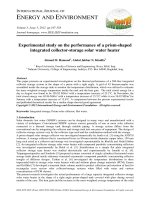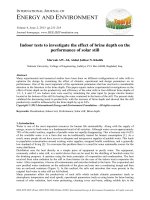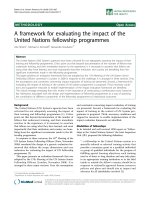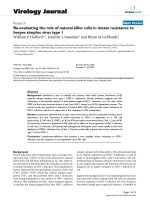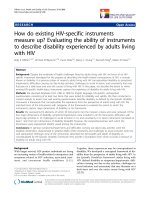evaluating the performance of 3rs waste practices case studyregionone municipality of tehran 2475 7675 1000130
Bạn đang xem bản rút gọn của tài liệu. Xem và tải ngay bản đầy đủ của tài liệu tại đây (392.1 KB, 6 trang )
Advances in Recycling and Waste
Management
Ahmadi, Adv Recycling Waste Manag 2017, 2:2
DOI: 10.4172/2475-7675.1000130
Research Article
OMICS International
Evaluating the Performance of 3Rs Waste Practices: Case Study-Region
One Municipality of Tehran
Mehri Ahmadi*
Institute for Environment and Development (LESTARI), University Kebangsaan Malaysia (UKM), Bangi, Selangor, Malaysia
∗Corresponding author: Mehri Ahmadi, Institute for Environment and Development (LESTARI), University Kebangsaan Malaysia (UKM), Bangi, Selangor, Malaysia,
Tel:+60389214144; E-mail:
Received date: July 26, 2016; Accepted date: Apr 29, 2017; Published date: May 03, 2017
Copyright: © 2017 Ahmadi M. This is an open-access article distributed under the terms of the Creative Commons Attribution License, which permits unrestricted use,
distribution, and reproduction in any medium, provided the original author and source are credited.
Abstract
This paper presents an examining household participation in 3Rs waste practice and the reasons of nonparticipant residents in 3Rs waste practice of the Region One Municipality of Tehran, Iran, and provide suggestions
for improving the MSWM system through formulation of local 3Rs waste strategies, particularly on separation at
source and recycling activities of the residents of Region One Municipality of Tehran, Iran which will help to promote
the sustainable waste management. A household survey using a self-completing questionnaire was done in Region
One Municipality of Tehran. A sample of 486 households participated in the household survey. The study revealed
that only 26% of the households take part in waste reduction activities and 20% in practice reuse and 29% in
separation at source. The traffic lights coding system model for ranking performance 3Rs-Reduce, reuse, and
recycle, the participation rate of households in the case study area in 3R performance ranked between low/medium
categories. Overall, survey results in the case study area about barriers to household’s participation in 3Rs waste
practice are categorised under the three main categorise, behavioural, awareness and situational barriers.
Keywords: Iran; Tehran; 3Rs; Municipal Solid waste management
Introduction
Rapid growing waste generation rates due to increasing population
growth and rapid urbanization, caused changing lifestyle and
consumption patterns are resulting in high costs of waste management
system include of waste collection, transportation, disposal, separation
of solid waste at the source [1]. At present issues like as public
awareness raising, increase of reduce; recycling and reuse, depletion of
landfill space, and institutional and legal barriers are unresolved
problem in Tehran city.
The Global Waste Management Goals (GWMO) launched by UNEP
and ISWA in year 2015 focused on ensuring a substantial reduction in
waste generation through prevention and the 3Rs (reduce, reuse,
recycle) by 2030 as one of the main goals [2].
However, there are several major limitations remained in the way of
municipal solid waste management improvement such as material
recovery and recycling as the best options for managing urban waste.
Therefore, the extraction of landfill gases to produce energy, or
incineration projects or the production of derivate fuels to be recycling
or recuperation operations will decrease UN habitat 2010.
Improper municipal waste management may result in serious
urban, sanitary and environmental problems such as unpleasant odour,
risk of explosion in landfill areas, as well as groundwater
contamination because of leachate percolation [3].
It seems one of the best solutions to support sustainable waste
management are through the application of the 3Rs policies and
effective implementation. The varying levels of success of the 3Rs
practice around the world have led to significant amount of research
being focused on explaining the variance observed in community
participation in waste practice specially focused on recycling and
Adv Recycling Waste Manag, an open access journal
ISSN: 2475-7675
composting rates and to improve the methods employed in household
waste management.
This article describes overview of 3R concept as a conceptual
framework. The major highlights are about the waste management
hierarchy. This waste hierarchy draws attention to the technical as well
as the social aspects of solid waste management. It has been discovered
that while the waste hierarchy dominates the agenda in cities of
developed countries, it receives little attention in cities of developing
countries. These countries still grapple with technical tasks and
participatory approaches for reach to 3R option goals. The success of
integrated waste management based on 3R approach depends on the
households’ participation. In this article three main subject of 3R were
posed to respondents to find out their manner toward 3R options.
The objectives of the study were examining household participation
in 3R waste practice and the reasons of non-participant residents in 3R
waste practice of the Region One Municipality of Tehran, Iran. The
results of the study will provide inputs into the formulation of local 3R
waste strategies, particularly on separation at source and recycling
activities of the residents of Region One Municipality of Tehran, Iran
which will help to promote the sustainable waste management.
3Rs Concept
The issue of 3Rs has become a significant policy approach for
sustainable development with the priorities placed on it by the World
Summit on Sustainable Development (WSSD) and one of its key
outcome documents-the '10 Years Framework Programme on
Sustainable Consumption and Production'. Also, Para 22 of the WSSD
Joint Plan of Implementation specifically endorses the 3R policy
approach as a means to achieve sustainable consumption and
production [4].
Volume 2 • Issue 2 • 1000130
Citation:
Ahmadi M (2017) Evaluating the Performance of 3Rs Waste Practices: Case Study-Region One Municipality of Tehran. Adv Recycling
Waste Manag 2: 130. doi:10.4172/2475-7675.1000130
Page 2 of 6
EU 2010 defines waste hierarchy order as a waste management
behaviour which relates to recycling, reusing and reduction [5]. The
EU waste policy legislation aims to move waste management up the
waste hierarchy with emphasis on 3R policies, through community
participation and awareness raising in the following 3R policies,
adopted in developed worlds briefly introduced.
In order to reduce the total amount of waste that goes into the land
fill, it is important to first reduce the volume of waste generated, then
reuse existing materials and finally recycle materials. This "3R"-reduce,
reuse and recycle-is a fundamental concept for waste management [6].
3Rs practices comprises different measures and skilful techniques to
minimize the volume of discarded waste materials that was generated
to dispose out [7]. Waste management hierarchy is the internationally
accepted guidelines for waste management practice, given emphases to
reduce waste at source, where waste can; it has been prevented, reuse
should be explored, Recycle option will be encouraged if the waste
cannot be reused.
In the following Figure, "3Rs" options briefly explained.
recyclable materials, Earlier studies indicate that nearly 20 per cent
reduction in waste generation is possible through simple housekeeping
measure that requires no or marginal investment. Proper design and
packaging of products with minimum volume of material and longer
useful life can reduce the waste considerably [10].
Reuse
The next best option for SWM is re-use and this encompasses the
utilization of an item after its primary use either for a purpose similar
to that which it was planned or for a completely new one. Reusing
items can be by repairing, selling or donating these items to charity
and community groups, and therefore this can reduce waste. Reuse is
preferable to recycling since the item doesn’t need to be reprocessed. In
addition to environmental consideration, sensitive reuse schemes can
have important social and cultural benefits [11]. This is exemplified in
the reuse of bottles (of beverages) or s��������������������������������������������������������������������������������������������������������������������������������������������������������������������������������������������������������������������������������������������������������������������������������������������������������������������������������������������������������������������������������������������������������������������������������������������������������������������������������������������������������������������������������������������������������������������������������������������������������������������������������������������������������������������������������������������������������������������������������������������������������������������������������������������������������������������������������������������������������������������������������������������������������������������������������������������������������������������������������������������������������������������������������������������������������������������������������������������������������������������������������������������������������������������������������������������������������������������������������������������������������������������������������������������������������������������������������������������������������������������������������������������������������������������������������������������������������������������������������������������������������������������������������������������������������������������������������������������������������������������������������������������������������������������������������������������������������������������������������������������������������������������������������������������������������������������������������������������������������������������������������������������������������������������������������������������������������������������������������������������������������������������������������������������������������������������������������������������������������������������������������������������������������������������������������������������������������������������������������������������������������������������������������������������������������������������������������������������������������������������������������������������������������������������������������������������������������������������������������������������������������������������������������������������������������������������������������������������������������������������������������������������������������������������������������������������������������������������������������������������������������������������������������������������������������������������������������������������������������������������������������������������������������������������������������������������������������������������������������������������������������������������������������������������������������������������������������������������������������������������������������������������������������������������������������������������������������������������������������������������������������������������������������������������������������������������������������������������������������������������������������������������������������������������������������������������������������������������������������������������������������������������������������������������������������������������������������������������������������������������������������������������������������������������������������������������������������������������������������������������������������������������������������������������������������������������������������������������������������������������������������������������������������������������������������������������������������������������������������������������������������������������������������������������������������������������������������������������������������������������������������������������������������������������������������������������������������������������������������������������������������������������������������������������������������������������������������������������������������������������������������������������������������������������������������������������������������������������������������������������������������������������������������������������������������������������������������������������������������������������������������������������������������������������������������������������������������������������������������������������������������������������������������������������������������������������������������������������������������������������������������������������������������������������������������������������������������������������������������������������������������������������������������������������������������������������������������������������������������������������������������������������������������������������������������������������������������������������������������������������������������������������������������������������������������������������������������������������������������������������������������������������������������������������������������������������������������������������������������������������������������������������������������������������������������������������������������������������������������������������������������������������������������������������������������������������������������������������������������������������������������������������������������������������������������������������������������������������������������������������������������������������������������������������������������������������������������������������������������������������������������������������������������������������������������������������������������������������������������������������������������������������������������������������������������������������������������������������������������������������������������������������������������������������������������������������������������������������������������������������������������������������������������������������������������������������������������������������������������������������������������������������������������������������������������������������������������������������������������������������������������������������������������������������������������������������������������������������������������������������������������������������������������������������������������������������������������������������������������������������������������������������������������������������������������������������������������������������������������������������������������������������������������������������������������������������������������������������������������������������������������������������������������������������������������������������������������������������������������������������������������������������������������������������������������������������������������������������������������������������������������������������������������������������������������������������������������������������������������������������������������������������������������������������������������������������������������������������������������������������������������������������������������������������������������������������������������������������������������������������������������������������������������������������������������������������������������������������������������������������������������������������������������������������������������������������������������������������������������������������������������������������������������������������������������������������������������������������������������������������������������������������������������������������������������������������������������������������������������������������������������������������������������������������������������������������������������������������������������������������������������������������������������������������������������������������������������������������������������������������������������������������������������could influence higher-level priorities, such as waste prevention
and minimization [20].
Also, most of the published research has focused on high-income
countries [1]. Even though data is generally lacking in the waste sector
of developing countries with only a few research conducted like as 3Rs
(reduce, reuse, recycle) policies to transition from waste management
to resource management. So, for the above-mentioned reasons, and
issues such as lack of universal definition and indicators and limited
information accessing concrete statistics for comparing rate of 3R
performance in both developed and developing countries are
impossible [21].
In Iran as a case example of this study, a considerable amount of
research work on solid waste management has already been conducted
in Iran particularly have been carried out to assess citizen participation
in recycling such as evaluating citizen attitudes and participation in
solid waste management that focused on households’ waste separationat-source [22], study on plastic recycling in Tehran, the citizen
participation in separation of waste, by assessment of different
influential factors [23], factors influencing householders’ waste
separation behaviour in Tehran city [3]. However, no study to
investigate the rate of 3Rs-Reduce, reuse, and recycle performance by
households in Iran.
Research Methods
The analytical framework is built around the concept of 3Rs. The
survey method adopted through household questionnaire surveys
which aimed to obtain the feedback of residents within the case study
area with corresponding reference to the performance of 3Rs options.
Taking into account a sample size of 486 households, the
questionnaires were distributed throughout the Region One
Municipality of Tehran. A semi-structured survey questionnaire with
closed and open-ended questions was used in this study.
First, households’ participation in 3Rs options measured by nominal
scale, Yes/No questions [24] and then, in the second part of the
questions peoples who answered yes, selected how they did their
practice and those answered No, in qualitative part of the questions,
mentioned the reasons for non-participation.
The data was analysed both qualitatively and quantitatively. The
statistical methods used in this research consisted of descriptive
statistics of frequency count and simple percentage analysis [25] for
quantitative result. The qualitative results were extracted from answers
and obvious duplicates removed. Second, the unsorted data were
allocated into three core categories, shown in Table 3.
For interpretation of the obtained results, the traffic lights coding
system from low to high used to rank performance 3Rs-Reduce, reuse,
and recycle in this study [2]. This scale consists of the following
structure: Low 0-9%, Low/ Medium 10-24%, Medium 25-44%,
Medium/ High 45-64%, High 65% and over.
Literature review purpose was to compare 3Rs performance around
the world. Results revealed policies differ among countries owing to
Adv Recycling Waste Manag, an open access journal
ISSN: 2475-7675
Volume 2 • Issue 2 • 1000130
Citation:
Ahmadi M (2017) Evaluating the Performance of 3Rs Waste Practices: Case Study-Region One Municipality of Tehran. Adv Recycling
Waste Manag 2: 130. doi:10.4172/2475-7675.1000130
Page 4 of 6
Results and Discussion
Other waste reusable tips
Households participation in 3Rs performance
Donate to poor people by yourself or to
charity centres
124
30%
Sell or exchange with other stuff with
local buyers
26
7%
Put out for collection by regular garbage
collectors
38
10%
Keep at home for future use
124
30%
No answer
11
3%
Three main questions were designed to get understanding about
respondents 3R option waste practice. These questions also asked the
respondents to give reasons for not taking part in 3R performance
practices. The rate of participation of respondents’ in 3R activity
mentioned in Table 1. Households take part in 3R performance
practice as follow: 26% for waste reduction, 20% for practice reuse and
29% for separation at source. The traffic lights coding system, which is
used to rank performance of 3Rs-Reduce, reuse, and recycle in this
study, the participation rate in the case study area, ranked between
low/medium categories [2].
Frequency
Percent
Table 3: Waste reuse tips in traditional manner.
3Rs options practice
Frequency
Percent
Recycling or separate at source
Practice ‘reduce’
120
26%
Practice ‘reuse’
94
20%
Separate wastes at source
136
29%
The rate of participation in sorting was 29%, while 71% did not
participate in recycling. About one-third of the respondents
participated in sorting waste. In the second part of the question
regarding separation at source; those who responded “YES” to this
question explained how they delivered recycled material. 52% of
households were engaged in sorting out, and then delivered to the
municipality recycled collection trucks, 41% delivered to the
municipality recycling kiosk (buy back centres) and only 7% sell to
informal recyclers or exchange with other goods.
Table 1: Households’ participation in 3Rs options practice.
Practice reduce of wastes
The rate of households’ participation in practices reduce of wastes
indicated 26% of respondents gave attention to waste reduction and
74% believed that it was not possible for them to reduce the amount of
waste they generated. Second part of the question regarding waste
reduction, those who responded Yes to this question explained how
they reduce waste with two actions, compact trash and buy products
with less packaging. The findings indicate that the majority of them,
48% mentioned they compact trash before disposal and 36% stated
they chose to buy products with less packaging items (such as reducing
on the packaging from where the purchases were made), and 12%
select both items. Table 2, presents the responses to the possibility of
reducing the amount of wastes.
The second part of the question designed for those who answered
'Yes' to the first part of question 26. The respondents were asked to
identify the recycling methods they used. The results are presented in
Table 4, deliver to municipality-recycled collection trucks and
deliveries to municipality recycling kiosks are generally considered the
most favourable methods of household.
Recycling tips (methods)
Deliver
to
municipality
collection trucks
Frequency
Percent
73
52%
57
41%
recycled
Deliver to municipality recycling kiosks
Waste reduction tips
Frequency
Percent
Compact trash
57
48%
Buy products with less packaging
44
36%
Both options
14
12%
Table 4: Waste recycling tips.
No answer
5
4%
Barriers to households’ 3Rs performance
Total
120
100%
Understanding households’ reasons for not participating is
important to improve participation in the 3Rs performance.
Respondents addressed many key problems for no participation in 3Rs
practices. The qualitative data from the questionnaire in the case study
area are categorised under the three main groups and summarized in
the Table 5.
Table 2: Waste reduction tips.
Practice reuse (through Municipal services)
The rate of household’s participation in waste reuse was 20% via
Tehran municipality reusable goods donation programme (137
Numbers) and the rest, 80% are via other traditional manner of
households. Only 10% of respondents mentioned putting out for
collection by regular garbage collectors. Table 3 shown waste reuse tips
in traditional manner by households in the case study, area in the
second part of the question regarding reuse, those who responded ‘No’
to this question explained how they treat to reusable goods.
Adv Recycling Waste Manag, an open access journal
ISSN: 2475-7675
Sell to informal recyclers or exchange
with other goods
6
7%
Total
100%
Variable of Individual Action Barriers
136
Frequency
Percent
103
22%
Behavioural Barriers
Not in the habit in lifestyle
Lack of Time (too busy to do their tasks
about 3Rs practices)
75
16%
Volume 2 • Issue 2 • 1000130
Citation:
Ahmadi M (2017) Evaluating the Performance of 3Rs Waste Practices: Case Study-Region One Municipality of Tehran. Adv Recycling
Waste Manag 2: 130. doi:10.4172/2475-7675.1000130
Page 5 of 6
Forget to do my task
46
10%
Table 5: Barriers of households’ participation in 3Rs performance.
Results indicated that although weekly recyclable collection service
existed, residents did not separate wastes because they had no time and
facilities to dispose their separated wastes or local people does not pay
attention in source separation benefits because they are not motivated
by authorities.
The study found that inadequate logistics hinder households’
participation in 3Rs option practices in the case study area. Some
people explained the inconvenience of storage both inside and outside
the house for disposal of waste and recycling. One barrier for citizens
in separating waste at source was that the kitchens are small and there
is not enough space to store the recycling bin. Respondents
complained about delays in waste collection and transportation by the
private contractor and inadequate recycling provision by the
municipality (wanted better and more convenient infrastructures for
recycling). This means that the municipality didn’t provide userfriendly mechanisms to increase reuse, recycling and waste reduction.
Study finding regarding situational barriers to individual waste
practice is in line with findings [26], it has been reported that
collection, transfer and transport practices are affected by improper
bin collection systems, poor route planning, lack of information about
collection schedule and, insufficient infrastructure. The recycling
behaviour was not only influenced by knowledge about local recycling
services, but was also determined by the availability of a kerbside
recycling scheme and availability of space for storing the recyclables.
In the same line with study finding, Inconvenience is considered as
one of the greatest barriers to recycling [27]. Overall, survey results in
the case study area about barriers to household’s participation in 3Rs
performance agree with the findings of Post who discovered that in
order for individuals to have responsible behaviour act to reduce waste
production or practice sustainable disposal methods, barriers relating
to knowledge, access, and convenience must be minimized.
Conclusion and Recommendations
The historical forces and mechanisms that have driven the evolution
of SWM in high-income countries can provide insight about how to
move forward in developing country.
•
•
•
References
1.
2.
3.
4.
5.
6.
7.
8.
9.
10.
11.
12.
13.
contexts Implications for the improvement of the households’
participation in in 3Rs performance in Region One Municipality of
Tehran in particular and in Tehran City in general, followings issues
must be put into consideration
14.
15.
•
16.
•
•
Governments should introduce and enforce the laws, regulations
and national policy frameworks which strengthened and expanded
to shift the emphasis from end-of-pipe approach to an integrated
waste management based on 3Rs options.
At local level integrated waste management strategy and action
plan for municipalities, especially in developing countries needs to
be developed and implemented.
There is a needing to organize household’s behavioural and
attitudinal change plan and programs to disseminate knowledge
and skills based on the social and cultural background of the case
study area-UNESCAP terms this phenomenon as “Trash is Cash.”
Adv Recycling Waste Manag, an open access journal
ISSN: 2475-7675
Municipality should facilitate public participation by making
adequate provision for recycling facilities and infrastructure for
example more buy-back centres should be created.
The householders must be sensitized and educated through mass
media for achieving 3R approach for integrated solid waste
management.
Available best practice especially from developing countries in the
areas of policy, institutional set up, financing mechanisms,
technology and infrastructure, roles and responsibilities of waste
actors, and political will and awareness would faster the 3R
approach improvement process.
17.
18.
19.
20.
21.
Wilson DC, Rodic L, Cowing MJ, Velis CA, Whiteman AD, et al. (2015)
Waste-aware benchmark indicators for integrated sustainable waste
management in cities. Waste Manag 35: 329-342.
Wilson DC, Velis CA (2015) Waste management-still a global challenge in
the 21st century: An evidence-based call for action. Waste Manag
33: 1049-1051.
Morabi H, Ishak MB, Abdullah AMH, Mahvi AH, Sabour MR, et al.
(2012) Study of Influencing Factors of the Consumer Separation
Behavior. IOSR-JESTFT 1: 27-32.
Srinivas (2015) Infopac on 3Rs, continuing Research Series E-018.
/>Iges (2005) promoting public participation in solid waste management,
Iges e-learning for sustainable development.
Jibril JDA, Sipan IB, Sapri M, Shika SA, Isa M, et al. (2012) 3Rs critical
success factor in solid waste management system for higher educational
institutions. JPSBS 5: 626-631.
Bouanini S (2013) The Importance of the 3R Principle of Municipal Solid
Waste Management for Achieving Sustainable Development. MJSS 4:
129-135.
Williams PT (2005) Waste Treatment and Disposal, 2nd edn West Sussex,
John Wiley and Sons, England.
Ramachandra TV (2011) Integrated management of municipal solid
waste, environmental security. HAH 30: 465-484.
UNEP (2003) A Manual for Water and Waste Management: What the
Tourism Industry Can Do to Improve its Performance, United Nations
Publication, pp: 3-13.
Marshall RE, Farahbakhsh K (2013) System Approaches to Integrated
Solid Waste Management in Developing Countries. Waste Manag 33:
988-1003.
Konteh FH (2009) Urban sanitation and health in the developing world:
reminiscing the nineteenth century industrial nations. Healt and Plac 15:
69-78.
/>Kollikkathara NH, Feng ES (2009) A purview of waste management
evolution: special emphasis on USA. Waste Manag 29: 974-985.
Mwiinga F (2014) Perceptions of Solid Waste Management and the role of
environmental education among selected residents of Choma Township
of Southern Zambia, University of Zambia.
EEA (2007) The Road from Landfilling to Recycling: Common
Destination, Different Routes, Copenhagen.
Troschinetz AM, Mihelcic JR (2009) Sustainable Recycling of Municipal
Solid Waste in Developing Countries. Waste Manag 29: 915-923.
Samiha B (2013) The importance of 3R principle of municipal solid waste
management for achieving sustainable development. MJSS 4: 129-135.
Gertsakis J, Lewis H (2003) Sustainability and the Waste Management
Hierarchy: A Discussion Paper on the Waste Management Hierarchy and
its Relationship to Sustainability. RMIT University, Melbourne, pp: 1-15.
Hotta Y (2014) 3R Policy Indicator Factsheets-Discussion Paper, Asia
Resource Circulation Policy Research Group.
Volume 2 • Issue 2 • 1000130
Citation:
Ahmadi M (2017) Evaluating the Performance of 3Rs Waste Practices: Case Study-Region One Municipality of Tehran. Adv Recycling
Waste Manag 2: 130. doi:10.4172/2475-7675.1000130
Page 6 of 6
22.
23.
24.
Nasrabadi T, Bidhendi NGR, Yavari AR, Mohammadnejad S (2008)
Evaluating Citizen Attitudes and Participation in Solid Waste
Management in Tehran, Iran. Jour Environ Heal 71: 30-33.
Majlessi M, Vaezi A (2014) Survey of effective Parameters in People
participation in Sorting the Waste (case study Tehran, IRAN, Region 1).
IRJBS 3: 86-91.
Sim NM, Wilson DC, Velis CA, Smith SR (2013) Waste management and
recycling in the former Soviet Union-case study of Bishkek, Kyrgyz
republic (Kyrgyzstan). Waste Manage Res 31: 106-125.
Adv Recycling Waste Manag, an open access journal
ISSN: 2475-7675
25.
26.
27.
Rai LP, Lal K (2000) Indicators of the information revolution. Technol in
Soc 22: 221-235.
Hezri AA (2010) Toward 3R-Based Waste Management: Policy Change in
Japan, Malaysia and the Philippines, in Kojima, 3R Policies for Southeast
and East Asia. ERIA pp: 274-290.
Abdelnaser O, Sarsour A, Kadir PAH (2012) An Investigation into the
Factors Influencing the Participation of Households in Recycling of Solid
Waste in Palestine. Inter Jour of Heal Econ 2: 1-19.
Volume 2 • Issue 2 • 1000130
